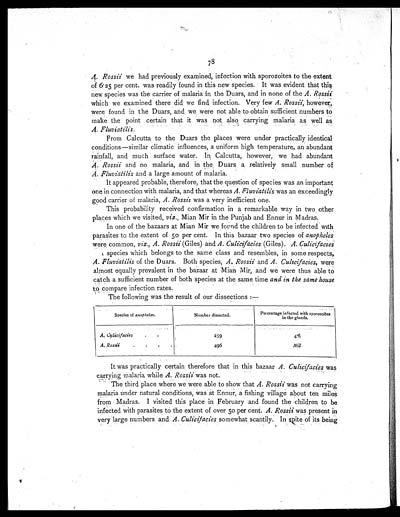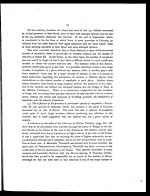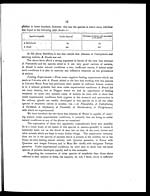Medicine - Institutions > Army health reports and medical documents > Scientific memoirs by officers of the Medical and Sanitary Departments of the Government of India > Number 2 - Malaria in India > Part II > Chapter III - Observations on the causes which influence the prevalence of malaria in different parts of India
(86) Page 78
Download files
Individual page:
Thumbnail gallery: Grid view | List view

78
A. Rossii we had previously examined, infection with sporozoites to the extent
of 6.25 per cent. was readily found in this new species. It was evident that this
new species was the carrier of malaria in the Duars, and in none of the A. Rossii
which we examined there did we find infection. Very few A. Rossii, however,
were found in the Duars, and we were not able to obtain sufficient numbers to
make the point certain that it was not also carrying malaria as well as
A. Fluviatilis.
From Calcutta to the Duars the places were under practically identical
conditions—similar climatic influences, a uniform high temperature, an abundant
rainfall, and much surface water. In Calcutta, however, we had abundant
A. Rossii and no malaria, and in the, Duars a relatively small number of
A. Fluviatilis and a large amount of malaria.
It appeared probable, therefore, that the question of species was an important
one in connection with malaria, and that whereas A. Fluviatilis was an exceedingly
good carrier of malaria, A. Rossii was a very inefficient one.
This probability received confirmation in a remarkable way in two other
places which we visited, viz., Mian Mir in the Punjab and Ennur in Madras.
In one of the bazaars at Mian Mir we found the children to be infected with
parasites to the extent of 50 per cent. In this bazaar two species of anopheles
were common, viz., A. Rossii (Giles) and A. Culicifacies (Giles). A. Culicifacies
species which belongs to the same class and resembles, in some respects,
A. Fluviatilis of the Duars. Both species, A. Rossii and A. Culicifacies, were
almost equally prevalent in the bazaar at Mian Mir, and we were thus able to
catch a sufficient number of both species at the same time and in the same house
to compare infection rates.
The following was the result of our dissections :—
| Species of anopheles. | Number dissected. | Percentage infected with sporozoites in the glands. |
| A. Culicifacies | 259 | 4.6 |
| A. Rossii. | 496 | Nil |
It was practically certain therefore that in this bazaar A. Culicifacies was
carrying malaria while A. Rossii was not.
The third place where we were able to show that A. Rossii was not carrying
malaria under natural conditions, was at Ennur, a fishing village about ten miles
from Madras. I visited this place in February and found the children to be
infected with parasites to the extent of over 50 per cent. A. Rossii was present in
very large numbers and A. Culicifacies somewhat scantily. In spite of its being
Set display mode to: Large image | Zoom image | Transcription
Images and transcriptions on this page, including medium image downloads, may be used under the Creative Commons Attribution 4.0 International Licence unless otherwise stated. ![]()
| Permanent URL | https://digital.nls.uk/75022647 |
|---|
| Shelfmark | IP/QB.10 |
|---|---|
| Additional NLS resources: | |




